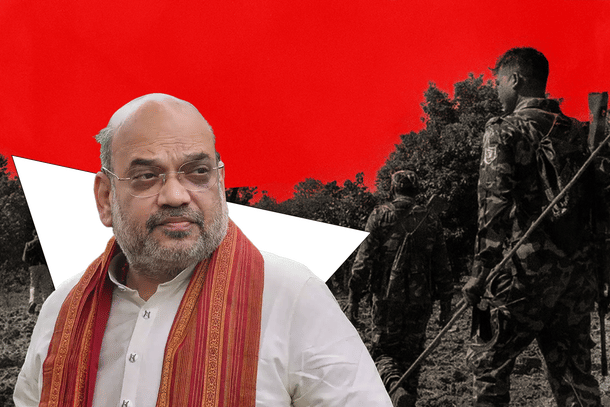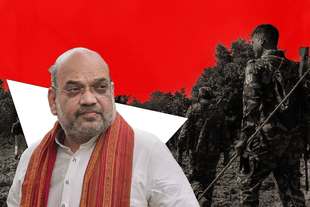Commentary
Beyond The Last Bullet: Forging A Destiny For The Red Corridor In 'Naxal Mukt Bharat'
Sougat Chakraborty
Jul 03, 2025, 11:15 AM | Updated 05:59 PM IST
Save & read from anywhere!
Bookmark stories for easy access on any device or the Swarajya app.


31 March 2026. That is the date committed by the Honourable Union Home Minister Amit Shah when India would be completely free from Naxalism. In 2025, security forces across India neutralised an estimated 210–220 Naxalites, according to official figures.
Chhattisgarh saw a significant portion of these incidents, with 153 casualties recorded by April, 124 of which occurred in the Bastar division. Notable operations included the 9 February incident in Bijapur’s Indravati National Park where 31 Naxalites were killed and another on 21 May in Narayanpur, resulting in 27 deaths, including that of prominent leader Nambala Keshava Rao.
For four decades, the shadow of Naxalism has loomed large over swathes of India, defining regions often termed the "Red Corridor." India has witnessed the ebb and flow of this protracted conflict, its human cost, and its profound impact on our internal security and social fabric. In 2009, former PM Dr Manmohan Singh called Naxalism “the greatest internal security threat to our country”.
Today, as we stand on the precipice of a "Naxal Mukt Bharat" (Naxal Free India), the complete eradication of this insurgency, the narrative must shift from merely extinguishing a threat to igniting a transformative future. The real challenge, and indeed the unparalleled opportunity, lies in what comes after the last shot is fired.
It is timely that we take a comprehensive look at the post-Naxal future, one that goes beyond conventional discourse.
The Uncharted Territory: Healing the Psychological Wounds of Conflict
Much has been discussed about the security apparatus and developmental schemes in Naxal-affected areas. However, an aspect often overlooked is the profound psychological and social scarring left behind by decades of conflict. A truly "Naxal Mukt Bharat" cannot be achieved without addressing these deep-seated wounds.
We must move beyond conventional rehabilitation. While financial aid and vocational training are crucial, they are merely the tip of the iceberg. How do we, as a nation, embark on a comprehensive programme of “psychological de-radicalisation” for those who have known only conflict and a particular, often distorted, ideology? This is not about re-education but about healing minds warped by years of indoctrination, fear, and violence.
Consider the challenges of reintegrating cadres who have lived outside mainstream society for years, their social skills atrophied, their trust in the state non-existent. We need specialised mental health interventions, community-based trauma counselling, and programmes that foster critical thinking and individual agency, rather than simply offering alternative livelihoods.
Furthermore, the “intergenerational trauma” within these communities is immense. Children born into conflict zones, families torn apart by violence – these wounds are passed down, creating cycles of distrust and potential future unrest. Our focus must be on creating psychosocial support systems that transcend individual rehabilitation, extending to families and entire villages.
This would involve a cadre of trained community counsellors, perhaps drawn from local populations themselves, who can facilitate dialogues, rebuild social cohesion, and help communities collectively process their past. This approach is rarely discussed, yet it is fundamental to preventing the re-emergence of extremist ideologies.
Finally, “trust-building with the state” cannot be transactional. It requires consistent, visible demonstrations of justice, empathy, and responsiveness. Imagine mobile legal aid clinics that address long-standing grievances, ombudsmen empowered to resolve land disputes swiftly, and public forums where state representatives genuinely listen to and act upon community concerns.
This goes beyond the opening of a school; it is about embedding a sense of justice and accountability within the administrative fabric, making the state a trusted partner, not a distant, often adversarial, entity.
Reimagining Governance: True Self-Determination and Economic Sovereignty
The roots of Naxalism often lie in grievances stemming from perceived state neglect and exploitation of tribal resources. A "Naxal Mukt Bharat" offers an unprecedented opportunity to redefine governance in these regions, moving towards genuine self-determination and economic sovereignty.
Traditional tribal governance structures, often undermined by both the state and Naxals, must be re-empowered, respecting the spirit of PESA and the Forest Rights Act. This means moving beyond tokenistic representation to genuine devolution of power, allowing local communities to make decisions about their resources, development, and future.
Could we envision Gram Sabhas in these areas becoming true centres of local governance, with significant budgetary and administrative authority, fostering a sense of ownership and accountability? This level of decentralised power has been discussed theoretically but rarely implemented with true conviction.
Since April 2015, significant infrastructure development has been undertaken in Left Wing Extremism (LWE) affected districts to foster financial inclusion, skill development, and education.
Specifically, in the 30 most affected districts, 1,007 bank branches and 937 ATMs have been established. Additionally, 5,731 new post offices have been opened across all LWE affected districts, along with the deployment of 37,850 Banking Correspondents (BCs) in the most impacted areas.
For skill enhancement, 48 Industrial Training Institutes (ITIs) and 61 Skill Development Centres (SDCs) are now operational. To improve educational access in tribal regions, 178 Eklavya Model Residential Schools (EMRSs) have been established.
Moreover, the Skill Development Scheme has reached all 48 districts, and a dedicated division of the National Investigation Agency (NIA) has been formed. Furthermore, 1,143 tribal youths have been recruited into the security forces, contributing to the overall security enhancement in these regions.
Economically, the post-Naxal landscape cannot simply revert to resource extraction. We must champion sustainable livelihoods that prioritise local communities and foster economic sovereignty. Beyond traditional agriculture, imagine integrated agro-processing zones specifically designed for tribal produce, promoting value addition to forest products, and establishing direct market linkages that cut out exploitative intermediaries.
Consider establishing a "Tribal Enterprise Development Fund" that offers seed capital and mentorship for local entrepreneurs, enabling them to build businesses that are culturally appropriate and environmentally sustainable. This moves beyond merely providing jobs to fostering genuine economic independence.
The Strategic Dividend: From Red Corridor to Green Growth Hubs
The cessation of conflict in these regions presents an immense strategic dividend for India, allowing us to redirect resources and re-imagine these areas as hubs for sustainable growth and innovation.
Imagine a future where the resources currently deployed for security operations – personnel, intelligence, infrastructure – are significantly redirected towards human capital investment. This is a profound shift from a security-first to a human-development-first paradigm.
Think about establishing centres of excellence for skill development tailored to the unique ecosystems of these regions, perhaps focusing on sustainable forestry management, organic farming techniques, renewable energy installation, or even traditional craft revival and digital marketing.
Could the "Red Corridor" be transformed into a "Green Growth Corridor"? Instead of traditional industrialisation, these regions, rich in natural resources and biodiversity, could become pioneering hubs for sustainable development.
Envision large-scale solar and wind energy projects, eco-tourism circuits designed and managed by local communities, and research centres focused on climate-resilient agriculture and biodiversity conservation. This is not just about economic development; it is about positioning India as a global leader in sustainable growth, leveraging its unique ecological assets.
The Philosophical Leap: Defining India's Post-Conflict Identity
The journey to a "Naxal Mukt Bharat" offers a unique opportunity for India to redefine its internal security doctrine and present a powerful soft power model to the world. Our internal security approach must undergo a philosophical shift from reactive force to proactive prevention.
This means prioritising intelligence gathering not just for threats, but for socio-economic grievances, understanding their root causes, and addressing them before they fester into unrest.
Furthermore, a truly "Naxal Mukt Bharat" could serve as a global case study for conflict resolution and nation-building. If India can effectively de-radicalise communities, empower local governance, and drive sustainable development in these historically conflict-ridden zones, it offers a powerful blueprint for other nations facing similar internal challenges.
This moves beyond mere "counter-insurgency" to a comprehensive model of societal transformation. It showcases the ability of a democratic nation to heal its internal wounds through justice, development, and inclusivity, transforming areas previously defined by violence and hatred into ones of peace and amity.
The Invitation: A Grand Alliance for a New Dawn
Achieving a "Naxal Mukt Bharat" is not just a government endeavour; it is a national project requiring a "Grand Alliance for Development." This means a truly collaborative effort involving the central and state governments, civil society organisations, the private sector, academic institutions, and most importantly, the local communities themselves.
We must define clear, long-term metrics of success that go beyond the absence of violence. Success should be measured by indices of human development, social cohesion, environmental sustainability, and the tangible sense of empowerment within these communities.
The transformation of regions like Jammu & Kashmir, where the focus has shifted from conflict to development and opportunity, offers a parallel. The decrease in militancy-related incidents, civilian deaths, and security force casualties in J&K underscores the impact of sustained efforts.
A "Naxal Mukt Bharat" signifies more than just resolving a security issue; it represents the initiation of a deep socio-economic and philosophical shift for India. It is a call for collaboration among investors, business owners, social organisations, and all citizens to collectively shape a fresh narrative.
This vision anticipates a future where conflict yields to advancement, unrest to peace, and the full range of colours symbolise a truly unified and prosperous nation.
The author is an IIMA Alumni with deep interest in National Security, International Relations, Public Policy & Governance. He also has a certification in Terrorism and Counterterrorism, a course of study offered by GeorgetownX, an online learning initiative of Georgetown University. (On X: @sougat18)




